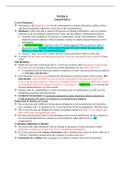Summary
Summary TEXT BOOK NOTES: Christopher Nowlin and Joan Brockman, An Introduction to Canadian Criminal Procedure and Evidence, 6th ed (Toronto: Nelson, 2017).
- Course
- Crim 330
- Institution
- Simon Fraser University (SFU )
Christopher Nowlin and Joan Brockman, An Introduction to Canadian Criminal Procedure and Evidence, 6th ed (Toronto: Nelson, 2017). Notes for the chapters from this book.
[Show more]




